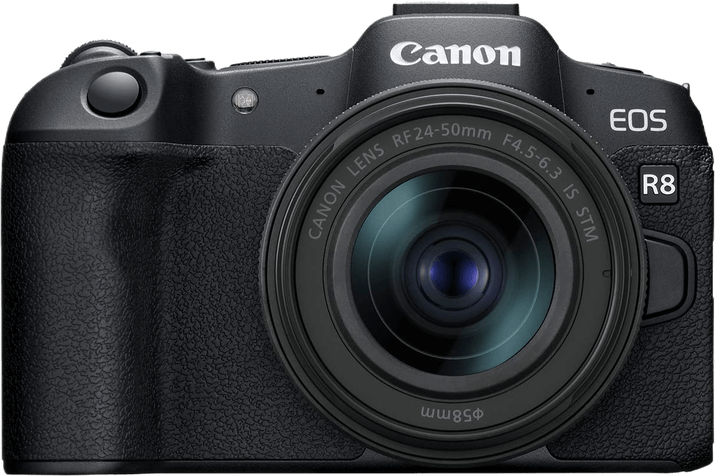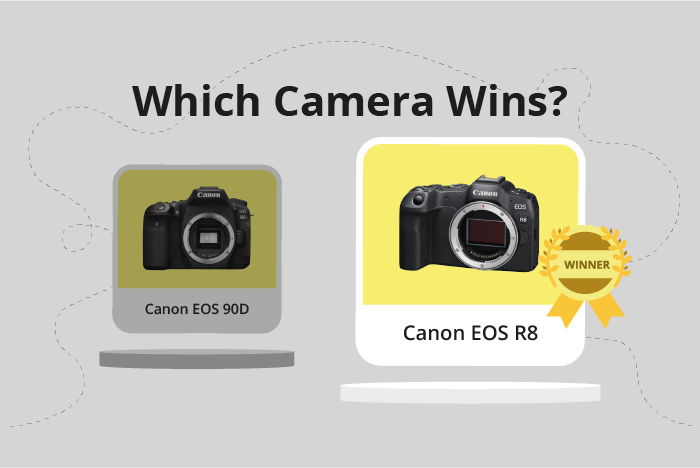Canon EOS 90D vs EOS R8 Comparison
Canon EOS 90D

Canon EOS R8

The Canon EOS R8 takes the lead with a score of 76/100, outperforming the Canon EOS 90D, which scored 67/100. Both cameras were released in different years, with the 90D arriving in 2019 and the R8 in 2023. Despite the difference in release years, they share similarities in their specifications.
Both cameras have the same launch price of $1199, but the R8 boasts a mirrorless design, making it lighter at 461g compared to the 701g DSLR 90D. The R8’s compact size (133 x 86 x 70mm) also gives it an advantage over the bulkier 90D (141 x 105 x 77mm).
However, the 90D has its merits, especially for those who prefer the traditional DSLR experience. Its heftier build may offer a more familiar feel for some photographers.
Taking into account the scores, specifications, and design, the Canon EOS R8 emerges as the superior camera, offering a lightweight and compact solution without compromising on performance. The Canon EOS 90D, while not as highly scored, still holds its ground as a reliable DSLR option.
Canon EOS 90D vs EOS R8 Overview and Optics
The Canon EOS R8 outperforms the Canon EOS 90D in optics, scoring 77/100 compared to the 90D’s 62/100. Both cameras share some common specifications, such as the CMOS sensor type, the absence of image stabilization, and the shooting speed. However, there are key differences that make the EOS R8 the superior choice in terms of optics.
The EOS R8 has a full-frame sensor, while the 90D has an APS-C sensor. The larger sensor size of the R8 contributes to its higher DXOMARK score of 94, compared to the 90D’s score of 58. This means that the R8 delivers better image quality, particularly in low-light conditions. Additionally, the EOS R8 features a more advanced Digic X processor, which further enhances its imaging capabilities.
While the EOS 90D has a higher megapixel count at 33 compared to the R8’s 24, the R8 compensates for this with its impressive 40 shooting speed. This makes the R8 better suited for capturing fast-paced action and sports photography. Furthermore, the EOS R8 is compatible with Canon’s RF lens mount, which offers a wider range of high-quality lenses designed specifically for full-frame mirrorless cameras.
In contrast, the EOS 90D uses the older EF/EF-S lens mount, which may limit its potential for future lens upgrades. However, the 90D’s higher megapixel count may be advantageous for those who prioritize capturing finer details in their images or require larger print sizes.
Considering these factors, the Canon EOS R8 emerges as the better choice for photographers seeking superior optics performance. Its full-frame sensor, advanced processor, and compatibility with the RF lens mount provide significant advantages over the EOS 90D. However, the 90D may still appeal to those who value higher resolution images and are content with the older EF/EF-S lens mount.
Canon EOS 90D vs EOS R8 Video Performance
The Canon EOS 90D and the Canon EOS R8 both have a video score of 91/100, indicating that they are equally matched in terms of video capabilities. Both cameras offer 4K video resolution with a maximum video dimension of 3840 x 2160, which provides high-quality video footage. Additionally, both cameras feature built-in time-lapse functionality, allowing users to create stunning time-lapse sequences without the need for additional equipment or software.
The Canon EOS 90D has a maximum video frame rate of 120fps, which is suitable for capturing smooth slow-motion footage. This feature is ideal for those who want to create dynamic and visually appealing videos, especially when capturing fast-moving subjects or action scenes.
On the other hand, the Canon EOS R8 surpasses the 90D with a maximum video frame rate of 180fps. This higher frame rate allows users to capture even smoother slow-motion footage, providing more flexibility in post-production and enhancing the overall visual quality of the final video. This advantage makes the EOS R8 a better choice for videographers who prioritize slow-motion capabilities.
While both cameras offer impressive video features, the Canon EOS R8 stands out slightly due to its higher maximum video frame rate. However, the Canon EOS 90D is still an excellent option for those who require high-quality video capabilities and built-in time-lapse functionality. Ultimately, the choice between these two cameras depends on the individual preferences and requirements of the user, as both offer exceptional video performance.
Canon EOS 90D vs EOS R8 Features and Benefits
The Canon EOS R8 emerges as the winner in this comparison with a feature score of 85/100, slightly ahead of the Canon EOS 90D’s score of 83/100. Both cameras share several common specifications, making them excellent choices for photographers and videographers alike.
Both the EOS 90D and EOS R8 have a 3-inch screen, touchscreen capabilities, flip screens, GPS, WIFI, and Bluetooth. These shared features make either camera a solid option for users who value connectivity and ease of use. However, the winning EOS R8 does have an advantage in terms of screen resolution, boasting a higher resolution of 1,620,000 dots compared to the EOS 90D’s 1,040,000 dots. This difference results in a clearer and sharper display on the EOS R8, enhancing the overall user experience.
On the other hand, the EOS 90D does not have any specific advantages over the EOS R8 in terms of features. Both cameras are evenly matched in their offerings, and the EOS R8 simply edges ahead due to its superior screen resolution. This means that while the EOS 90D is a strong contender, it does not surpass the EOS R8 in any significant way.
Considering the similar feature sets and only a minor difference in their scores, both the Canon EOS 90D and EOS R8 are excellent options for photographers and videographers. The higher screen resolution of the EOS R8 makes it the better choice for users who prioritize display clarity. However, the EOS 90D remains a reliable option with comparable features and only a slightly lower score. The final decision ultimately depends on individual user preferences and priorities.
Canon EOS 90D vs EOS R8 Storage and Battery
The Canon EOS 90D outperforms the Canon EOS R8 in storage and battery with a score of 48/100 compared to 35/100. Both cameras have one memory card slot and accept SD, SDHC, and SDXC cards. However, the 90D is compatible with UHS-II cards, while the R8 supports both UHS-I and II cards.
The EOS 90D’s superior battery life of 1300 shots, compared to the R8’s 370 shots, contributes to its higher score. Additionally, the 90D uses the LP-E6N battery type, which is more powerful than the R8’s LP-E17 battery.
On the other hand, the EOS R8 offers USB charging, a feature not available in the EOS 90D. This gives the R8 an advantage in terms of convenience and flexibility when charging the battery.
Considering the storage and battery specifications, the Canon EOS 90D clearly surpasses the Canon EOS R8 in terms of battery life and power. The R8, however, offers the added benefit of USB charging, which may appeal to some users.
Canon EOS 90D vs EOS R8 – Our Verdict
Are you still undecided about which camera is right for you? Have a look at these popular comparisons that feature the Canon EOS 90D or the Canon EOS R8:

